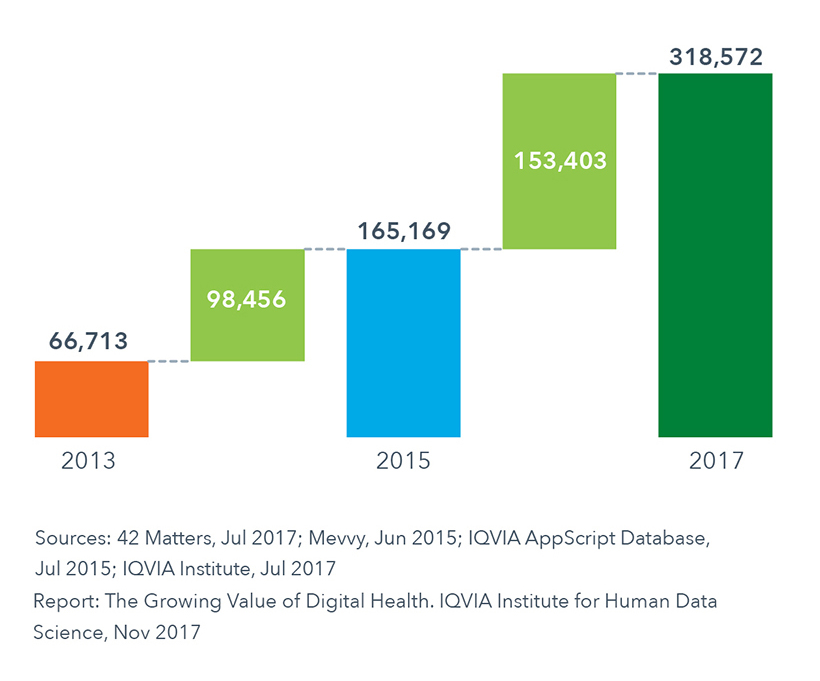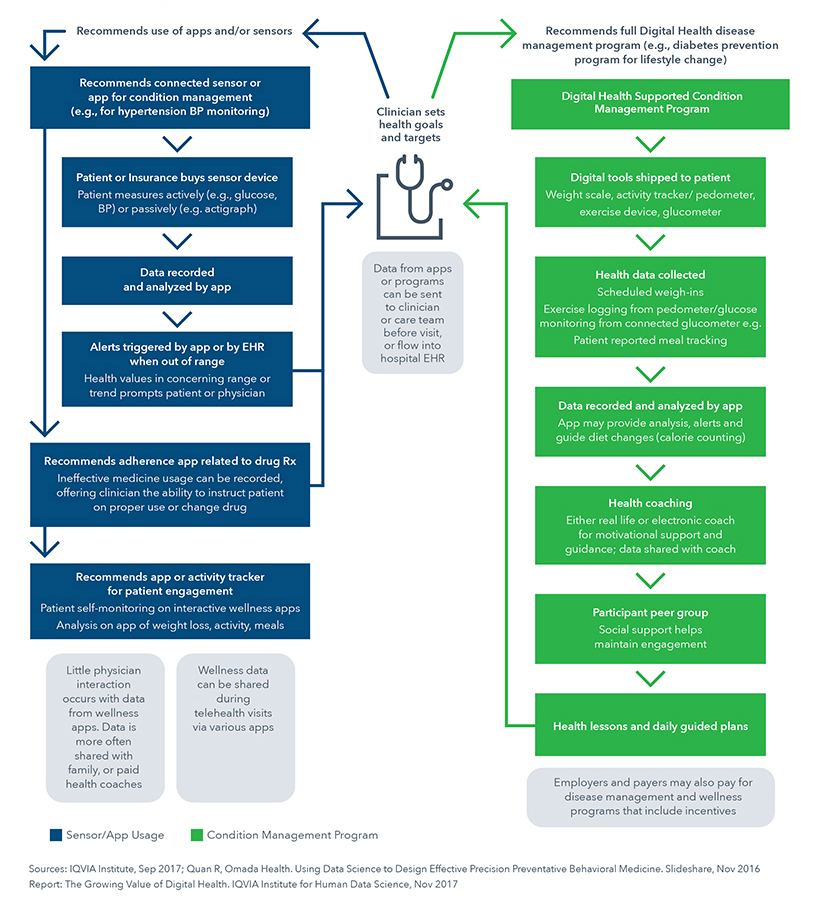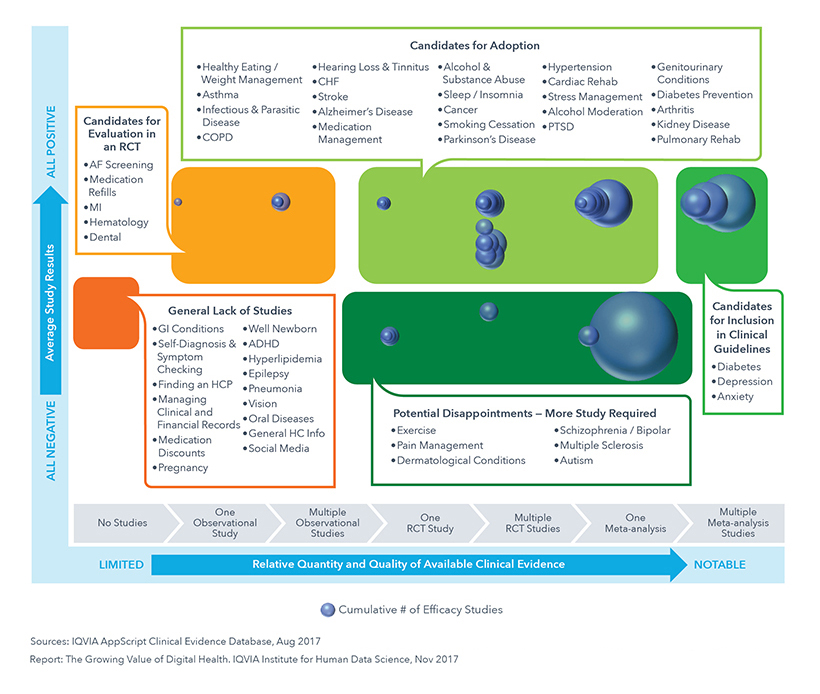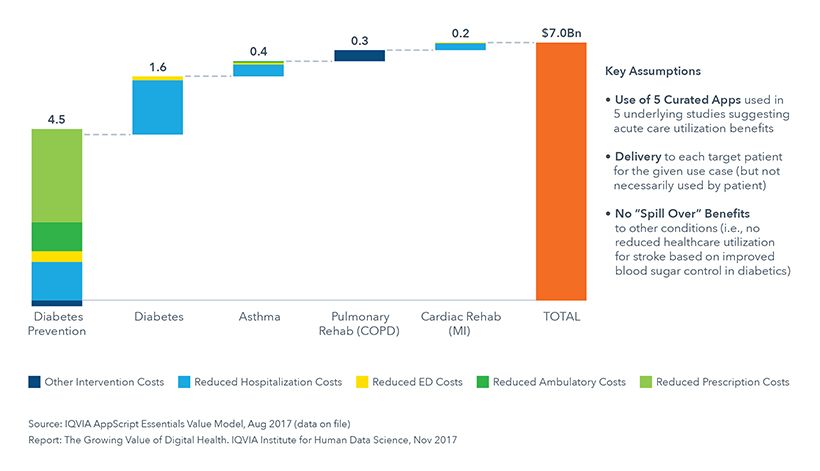By IQVIA Institute | Nov 7, 2017
About the Report
The proliferation of Digital Health tools, including mobile health apps and wearable sensors, holds great promise for improving human health. Over 318,000 health apps are now available on top app stores worldwide with more than 200 health apps being added each day. This report on Digital Health examines trends in three areas — innovation, evidence and adoption — to assess whether these new tools are positioned to have a fundamental impact on patient care. As Digital Health brings new approaches to the management of health conditions this report explores the growing body of evidence that demonstrates their impact on human health and extrapolates the potential cost savings to the U.S. healthcare system.
Report Summary
The impact of Digital Health on patient care is accelerating with the increasing adoption of mobile health apps and wearable sensors. Health-related mobile applications available to consumers now surpass 318,000 — nearly double the number available just two years ago. This rapid app expansion, coupled with more than 340 consumer wearable devices on the market worldwide, provide evidence of Digital Health’s accelerating innovation. At this time, there is at least one high-quality app for each step of the patient journey. While the majority of mobile health apps available are general wellness apps, the number of health condition management apps—those often associated with patient care—are increasing at a faster rate, and now represent 40 percent of all health related apps.
The overall body of clinical evidence on app efficacy has grown substantially and now includes 571 published studies, enabling the identification of a list of top apps with increasingly robust clinical evidence. The use of such Digital Health apps in just five patient populations where they have proven reductions in acute care utilization (diabetes prevention, diabetes, asthma, cardiac rehabilitation and pulmonary rehabilitation) could save the U.S. healthcare system an estimated $7 billion per year. This represents about 1.4% of total costs in these patient populations. If this level of savings could be extrapolated across total national health expenditure, annual cost savings of $46 billion could be achieved.
Efforts by patient care organizations to fit Digital Health tools into clinical practice has progressed, with 540 current clinical trials in the U.S. incorporating these tools and an estimated 20% of large health systems shifting from pilot Digital Health programs to more full-scale rollouts. However, despite progress to date, a number of barriers still exist to widespread adoption by patient care institutions, and only an intermediate level of adoption has yet occurred. A variety of industry and policy initiatives have now emerged to address these barriers and accelerate the ongoing adoption of Digital Health tools by care provider organizations. Within the next ten years, the use of Digital Health is likely to be mainstream for most organizations delivering human health.
Key Findings
The number of apps is increasing and shifting towards health condition management

- The number of Digital Health apps have increased substantially. There are now over 318,000 health apps worldwide — nearly double the number of apps available in 2015 and nearly five times those available in 2013.
- Health apps appear to be improving based on user experience. Fifty five percent of apps launched within the past two years have ratings higher than four stars, compared to 31 percent of those launched before 2015.
- Apps focused on health condition management — often associated with patient care — are growing and now account for 40% of all apps.
- Very few apps account for the majority of downloads; just 41 apps, each with over 10 million downloads, account for nearly half of all app downloads.
Mobile apps and wearable sensors are helping clinicians manage health conditions

- Over 55% of the most-downloaded health apps now use sensor data to track human health. Although currently focused on activity tracking for wellness management, innovation in sensors also enables detection of patient vital signs for disease and condition management.
- More than 340 wearable devices are now available to consumers worldwide, helping to enable remote patient monitoring.
- New value will be brought to healthcare by algorithms built on top of wearable activity monitors to create “digital biomarkers” of health. By tracking parameters beyond sleep and steps that correlate to disease severity, these digital tools will contribute to precision medicine, enabling stratification of patients by their symptoms.
Clinical evidence regarding Digital Health efficacy has grown substantially

- There are 571 published studies, including randomized controlled trials (RCTs) and meta-analysis studies, which enable the identification of a list of Top Apps with increasingly robust clinical evidence.
- Particularly compelling evidence now exists for use of apps in diabetes, depression and anxiety, making these categories strong candidates for inclusion in standard of care recommendation by clinical guideline writers.
- An additional 24 use categories have one or more RCTs with positive results making associated apps strong candidates for adoption across provider organizations and payer networks.
- Additional evidence-building efforts continue with 860 clinical trials worldwide now incorporating Digital Health tools, including 540 in the U.S. 82% of these trials are sponsored by patient care institutions, demonstrating increased efforts to fit Digital Health into clinical practice.
Use of health apps in five therapy areas could produce $7 billion in annual savings

- Digital Health apps and wearables have proven reductions in acute care utilization across five patient populations (diabetes prevention, diabetes care, asthma, cardiac rehabilitation and pulmonary rehabilitation).
- The use of Digital Health apps in just these five patient populations could save the U.S. healthcare system an estimated $7Bn per year. This represents about 1.4 percent of total costs in these patient populations.
- If this level of savings could be extrapolated across total national health expenditure, annual cost savings of $46Bn could be achieved.










